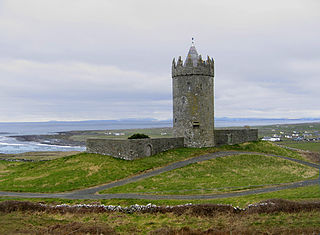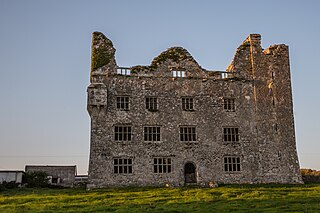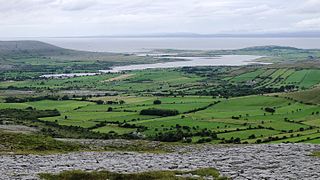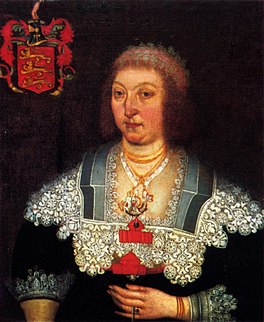
The Burren is a region of environmental interest primarily located in northwestern County Clare, Ireland, dominated by glaciated karst landscape. It measures, depending on the definition, between 250 square kilometres (97 sq mi) and 560 square kilometres (220 sq mi). The name is most often applied to the area within the circle made by the villages of Tubber, Corofin, Kilfenora, Lisdoonvarna, and Ballyvaughan, and Kinvara in extreme south-western Galway, including the adjacent coastline.

Kilfenora is a village and a civil parish in County Clare, Ireland. It is situated south of the karst limestone region known as the Burren. Since medieval times when it was the episcopal see of the Bishop of Kilfenora, it has been known as the "City of the Crosses" for its seven high crosses. The village had around 220 inhabitants in 2011. Much of the TV show Father Ted (1995–98) was filmed there.

Dromoland Castle is a castle, located near Newmarket-on-Fergus in County Clare, Ireland. It is operated as a 5-star luxury hotel with a golf course, with its restaurant, the Earl of Thomond, being awarded a Michelin star in 1995, under head chef Jean Baptiste Molinari.

Ennistymon or Ennistimon is a country market town in County Clare, near the west coast of Ireland. The River Inagh, with its small rapids known as the Cascades, runs through the town, behind the main street. A bridge across the river leads to nearby Lahinch, on the N67 national secondary road. The town is connected to Ennis by the N85, continuing the settlement's main street.

Liscannor is a coastal village in County Clare, Ireland.

Doonagore Castle is a round 16th-century tower house with a small walled enclosure located about 1 km south of the coastal village of Doolin in County Clare, Ireland. Its name may be derived from Dún na Gabhair, meaning "the fort of the rounded hills" or the "fort of the goats". Doonagore Castle is at present a private holiday home, inaccessible to the public.

Corofin is a village on the River Fergus in northern County Clare in Ireland and a Catholic parish with the same name.

Kilshanny is a village and a civil parish in west County Clare, Ireland.

Leamaneh Castle is a ruined castle located in the townland of Leamaneh North, parish of Kilnaboy, between the villages of Corofin and Kilfenora at the border of the region known as the Burren in County Clare, Ireland. It consists of a 15th-century tower house and a 17th-century mansion.
Clare was a constituency represented in the Irish House of Commons until 1800.

Gregans Castle is the name applied to both a 15th-century tower house and a Georgian-style house in the Burren region of County Clare, Ireland, near the village of Ballyvaughan. The latter dates from 1750 and is associated with the Martyn and O'Lochlainn families. The tower house is across the road from the modern house, which is now a hotel.

Ennistymon House was a former country house in the village of Ennistymon, County Clare in Ireland. Built on the elevated site of a medieval castle it has now been incorporated into the Falls Hotel.

Newtown Castle is a 16th-century tower house, located close to the village of Ballyvaughan within the Burren area of County Clare, Ireland. Uniquely for a tower house of its type in Ireland, Newtown Castle is mostly cylindrical in shape but rises from a square pyramidical base. It is today part of the Burren College of Art.

Dough Castle is a ruined tower house at Lahinch in County Clare, western Ireland. It was established by the O'Conors in the early 14th century, but nothing remains of the original structures.

Rathborney, sometimes Rathbourney, is a civil parish in the Barony of Burren in County Clare, Ireland.

Oughtmama is a civil parish in County Clare. It lies in the Burren, a region in the northwest of the county. It contains many antiquities, including three early-medieval Christian churches, ruined castles, prehistoric cairns and ring forts and two Martello Towers built in the early 19th century.

Killilagh or Killeilagh is a civil parish in County Clare, Ireland. It contains the village of Doolin.

Gleninagh or Glaninagh is a civil parish in County Clare, Ireland. It lies in the extreme northwest of the Burren, on the south of the mouth of Galway Bay. It is known for the well-preserved L-plan Gleninagh Castle, a 16th-century tower house. The parish also contains the lighthouse on Black Head.

Shanmuckinish Castle is a ruined tower house located in Drumcreehy civil parish of County Clare, Ireland.

Máire Rua O'Brien was an Irish aristocrat, and notorious figure in Irish legend for her violent and murderous actions.






















